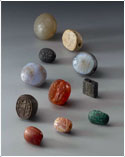

The Paleolithic period is the earliest period in human evolution and the longest phase in the history of mankind. The most abundant remains of the Paleolithic cultures are a variety of stone tools. During this entire period flint was the main raw material that was used by early hunters and food-gatherers to manufacture tools. The period is divided into three phases:
Lower Paleolithic (1,400,000–245,000 BP [before present])
Middle Paleolithic (245,000–45,000 BP)
Upper Paleolithic (45,000–24,000 BP)
The Lower Paleolithic period is subdivided into three cultural phases: Early Acheulean, Late Acheulean and the Acheulo-Yabrodian. Israel is a principal geographical bridge between Africa and Eurasia and was one of the main migration routes of early hominids to Asia and Europe. Choppers, handaxes and cleavers were typical stone tools of this period. They are frequently associated with faunal remains, including species of mega-fauna that are now extinct, among them elephants, rhinoceros, wild sheep and aurochs.
The Middle Paleolithic period is also subdivided into three cultural phases: Early Mousterian, Middle Mousterian, and Late Mousterian. One of the indicators of the Mousterian culture is the ‘Levallois’ stone-knapping technique, whose main products are points, flakes and blades. Other categories of tools that are found in this period are the Abu-Sif points, the Mousterian points and several types of scrapers. Two early human species appeared in Israel during the Middle Paleolithic period, the ‘archaic’ Homo sapiens and the Neanderthal. These two hominids are associated with the Mousterian stone-tool industry. Burials of both ‘archaic’ Homo sapiens and Neanderthals were discovered in caves in northern Israel. Intentional burials of ‘archaic’ Homo sapiens that were discovered in Qafzeh cave date to about 100,000 years BP, and are the oldest known remains of modern humans outside of Africa.
The Upper Paleolithic period is usually subdivided into two cultural phases. The Early Upper Paleolithic comprises the Early Ahmarian and the Aurignacian cultures. The Ahmarian culture is typical of the southern Levant — present day Israel, Jordan, Lebanon and Syria. It is dominated by such tool categories as retouched blades and bladelets, al-Wad points, end-scrapers and burins. The Aurignacian culture arrived from Europe later, and appears to co-exist with the Ahmarian. Aurignacian sites are known mainly from cave sites in northern Israel. The assemblages feature flakes, thick blades, Dufour (twisted) bladelets, carinated scrapers, retouched blades and bladelets. The Late Upper Paleolithic includes the Atlitian culture which is characterized by burins and rarely by points, and the Late Ahmarian, or Masraqan. Along with flint tools, Upper Paleolithic assemblages contain bone and horn objects, beads and the earliest stone grinding tools.
|







